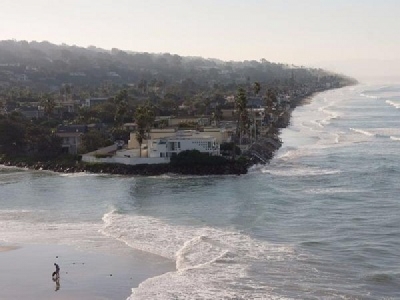
Posted on April 3, 2018
By Sebastian Montes, Del Mar Times
With decades of research, planning and negotiation ahead, Del Mar has begun formulating its strategies for counteracting sea-level rise by spreading sand on the city’s beaches.
The city’s Sea-Level Rise Stakeholder-Technical Advisory Committee (STAC) took its first tentative steps last week in setting Del Mar on a course that will focus on expanded dredging of the San Dieguito River, tapping into a massive reservoir of sand at Lake Hodges, and seeking federal compensation for the impacts of the Oceanside jetty.
Earlier this year, STAC decided—over the sharp objections of the California Coastal Commission and the Surfrider Foundation—to eliminate “managed retreat” as an option and to instead prioritize “beach nourishment,” or placing sand onto a beach.
That decision was made largely in the blind, coming months before the committee’s environmental consultant had completed the first-ever comprehensive analysis of sand migration patterns in Del Mar.
The consultant, Environmental Science Associates (ESA), developed a “sand budget” that balances Del Mar’s gains and losses in the ever-shifting sand network known as the Oceanside Littoral Cell. Once seasonal currents, tidal patterns and a dozen other forces are factored in, Del Mar’s beaches appear to be losing more than 17,000 cubic yards per year, according to ESA.
Counteracting that immediate deficit by finding and spreading sand on Del Mar’s beaches is expected to cost more than $500,000 per year over the upcoming decade. As the Pacific Ocean rises, so too will the amount of sand needed to counterbalance it. At 1 foot of sea-level rise, Del Mar’s sand needs are expected to jump to more than 50,000 cubic yards and $850,000 per year. The amounts escalate steeply from there.
The impact of the Oceanside jetty has become increasingly central to STAC’s work over the past six months, with anecdotal accounts and some scientific evidence suggesting that the jetty could be a significant obstacle in Del Mar’s sand supply.
“I’m old enough to remember when they put in that jetty,” said STAC member Kim Fletcher, grandson of the developer for whom Solana Beach’s Fletcher Cove is named. “After the jetty was in, there were people in Oceanside and Carlsbad that were complaining about the loss of sand on their beach, and now that effect seems have to have moved south all the way to Del Mar and Solana Beach. I’m not saying you tear down the jetty but maybe there’s another groin that can be put out there that redirects the currents back in again.”
Several committee members went even further, asking ESA to look more deeply into what sand migration patterns would look like if the jetty weren’t there, as a basis for lobbying the federal government to help defray the costs of Del Mar’s massive upcoming dredging expenses.
The largest cause of Del Mar’s sand deficit is Lake Hodges Dam. ESA’s analysis determined that the dam has siphoned off more than three-quarters of Del Mar’s natural sand supply. Roughly 4.5 million cubic yards of sand has since accumulated behind the dam—enough to satisfy Del Mar’s sand needs for more than 100 years, even under the most dire climate predictions.
Several STAC members and city officials are bandying about the idea of convincing the county water authority to impose a surcharge on water bills countywide, the revenues of which would pay to dredge and transport Lake Hodges sand to Del Mar beaches.
“Everybody in the county, even if by accident, is participating in the water system,” said Del Mar Mayor Dwight Worden. “It’s not fair that just the coastal cities would have to pay for something that everybody had a part in creating.”
In the shorter term, Del Mar should be able to find some relief from dredging the San Dieguito River and its lagoon. The terms of the lagoon’s $90 million restoration require Southern California Edison (SCE) to manage the wetlands until various metrics and milestones are met, after which time Del Mar will have to maintain the river on its own. That timeline depends on a slew of far-ranging variables, but should last somewhere around 30 more years.
Ideas include more frequent dredging—SCE’s permit allows dredging as often as every eight months—and having the city pay SCE to do additional dredging whenever its crews head out to meet SCE’s obligation to keep the rivermouth and channel open.
SCE established a lagoon restoration endowment in 2004 that has since grown “well past $1 million,” said Laura Demarco, who was the inaugural chairwoman of the endowment’s investment committee. But even under the most profitable forecasts, Demarco said, the endowment will fall far short of covering Del Mar’s looming sand expenses.
“So it’s going to have to come from the city, it’s going to have to come from the federal government, and I think you’re going to need to get some lawyers involved and some very good oceanographers to make the case that this [sand] deficit has been caused by that jetty,” Demarco said.
One step already underway is that city officials are going to work with the Coastal Commission to obtain a Sand Compatibility and Opportunistic Use Program (SCOUP) permit, a program in which cities can receive up to 150,000 cubic yards of sand as it becomes available on a case-by-case basis. Solana Beach and Encinitas, for example, already have SCOUP permits.
The city council is set to hold its first discussion of Del Mar’s sea-level rise adaptation plan on April 16.
Source: Del Mar Times





